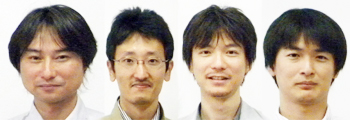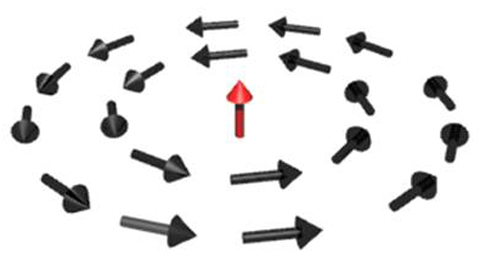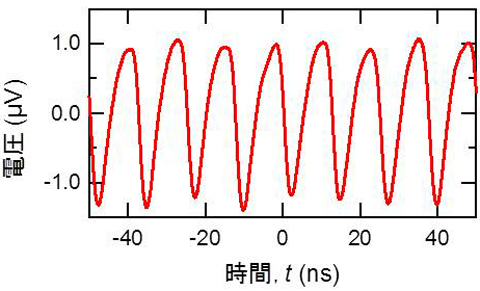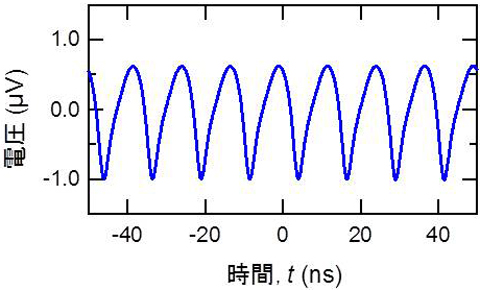May 23, 2012

(From left) Prof. Ono, Mr. Tanabe, Assis. Prof. Chiba and Lec. Ohe.
Professor Teruo Ono, Associate Professor Kensuke Kobayashi, Assistant Professor Daichi Chiba, Doctoral Cource Student Mr. Kenji Tanabe of the Institute of Chemical Research,, Lecturer Jun-ichiro Ohe (Toho University), Senior Researcher Shinya Kasai (National Institute for Materials Science), Associate Professor Hiroshi Kohno (Osaka University), Professor Stewart E. Barnes (University of Miami), and Director Sadamichi Maekawa (Japan Atomic Energy Agency) demonstrate that a spin-motive force is induced by a dynamic magnetic vortex. This study is published in "Nature Communications".(Online Publication, May 22, 2012)
Summary
Classical electromagnetism insists an electromotive force is induced, in a circuit, by a time-varying magnetic field. This is embodied in Faraday's 1831 law of induction, a fundamental law of physics, and a building block of modern electronics. At a classical level, the associated Lorentz force is proportional to, and reflects, the charge of an electron. The quantum mechanical theory of Dirac demands an electron has also an intrinsic magnetic moment reflecting its "spin". There are additional forces associated with the electron's spin and this leads to the possibility of spin-motive forces. Such a motive force is a complex phenomenon associated with the non-uniform, dynamics of magnetic structures, usually in ferromagnets. Previously, this dynamic nature of this spin-motive forces has not been confirmed.
 |
|
Figure 1: Schematic diagram of a magnetic vortex. This is a non-uniform magnetic structure. A vortex motion is induced by an external magnetic field and this induces a spin-motive force. The perpendicular component (red arrow) of the magnetization at the center of the magnetic vortex corresponds to its core. |
Our group has realized local-in-space, and in time, measurement of the spin-motive force corresponding to a magnetic vortex, as illustrated in Figure 1. Such complex magnetic structures occur in micrometer ferromagnetic discs with suitably chosen dimensions. As illustrated, the magnetization rotates, in the plane of the sample, about a central core region where the magnetization is perpendicular to the disc. Because of the highly non-uniform magnetization in the core region, and reflecting the dynamics of a vortex excited by a radio frequency field, there is a large spin-motive force.
 |
|
Figure 2: The detected spin-motive force signal. |

|
|
Figure 3: The computer simulated spin-motive force signal with parameters appropriate to the experiment. |
When excited by an ac magnetic field a magnetic vortex has a resonant mode, leading to a rapid core motion. The observed spin-motive force follows the amplitude of this resonant mode. Figure 2 shows the ac voltage detected near the moving core. A periodic signal of about 1 microvolt is detected. The observed signal is peaked at the the resonant frequency of the magnetic vortex, demonstrating that it arises from the core motion. The experimental results are fully consistent with spin-motive theory of Barnes and Maekawa[1]. Shown in Figure 3 is the numerically computed signal with parameters which corresponding to Figure 2. The agreement is very good. We have thereby demonstrated that a spin-motive force is induced by a dynamic magnetic vortex in the nano-metric area near to its core.
Reference
[1] S. E. Barnes, & S. Maekawa, Phys. Rev. Lett. 98, 246601 (2007).
[2] A. Stern, Phys. Rev. Lett. 68, 1022 (1992).
[3] T. Shinjo et al. Science 289, 930 (2000).
[4] J. Ohe & S. Maekawa, J. Appl. Phys. 105, 07C706 (2009).
Paper Information
[DOI] http://dx.doi.org/10.1038/ncomms1824
Tanabe K, Chiba D, Ohe J, Kasai S, Kohno H, Barnes SE, Maekawa S, Kobayashi K, Ono T. Spin-motive force due to a gyrating magnetic vortex. Nature Communications 3, Article number: 845, 2012/05/22/online. doi:10.1038/ncomms1824
This work was supported in part by Grant-in-Aid for Scientific Research (S) from JSPS, Grant-in-Aid for Scientific Research in Priority Area "Creation and control of spin current" from Ministry of Education, Culture, Sports, Science and Technology.

